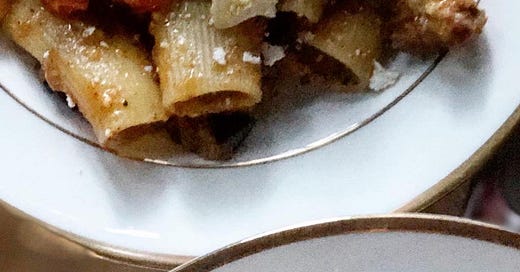“Are you amazing right now?”
It wasn’t exactly a question I expected to be asked. Not at 10 am in the morning at the farmers’ market while buying eggs. My answer was as quick as the question. “Not really,” I said.
“But you’re talking to me and I’m amazing, so you are amazing too,” the vendor assured me. “Life is amazing. You’ll see – 2022 is going to be different. We’re going to choose different things now. Choose love.”
How right he was. And of course, I was choosing love. My market basket was full of love: everything tended to with care, thoughtfully grown, painstakingly harvested. Corn, big and firm and sunny yellow; juicy nectarines; small Kirby cucumbers for pickling; fat eggplant; freshly baked sourdough bread; zucchini and raspberries and Sungold tomatoes, as small as marbles and exquisitely sweet. Those eggs. It’s no wonder that everything tastes so good right now, sown and grown as it all is, with love.
In a world that feels fraught with anger, and sadness and despair and hopelessness, choosing love seems like a very sensible thing to do.
Simple acts of kindness
“One word frees us of all the weight and pain of life: that word is love.”
― Sophocles
There are as many words - and definitions - for love as there are for snow. It started with the ancient Greeks, who classified love methodically, as with everything they studied and philosophised about. From unconditional love, romantic love, love amongst friends and family, to self love and the concept of hospitality defined as a type of love, those Greeks dissected love as scientifically as a bug under a microscope.
But I think it’s much more interesting to observe what we do with that love, whatever form it takes. And never more so than now.
Leaving romantic love aside (and this has certainly been a trying year for that), I would argue that the notion of kindness is the most important expression of love these days. And with that, a healthy dose of caring.
We’ve been divided over so many things, from geopolitics, vaccines and masks, to more fundamentally what the future will look like, and who we’ll be, that a spoonful of sugar might very much be in order.
As we step into a way of behaving and being in the world, we’re all carrying an invisible bag of rocks around, and while some bags may be smaller than others, it’s an extra weight nonetheless.
Just like the servers and frontline workers and volunteers who showed up as close as your neighbourhood and as far away as Haiti and Afghanistan, we too need to show up. To offer kindness, wrapped in patience and empathy.
Or, as my farmer friend would say, choose amazing and choose love.
Pasta alla Norma
serves 4
It’s true that pasta is usually associated with cooler fall days and winter months, unless it’s a cold rice or pasta salad eaten in the extreme heat of summer, and preferably at the beach. But it’s also true that a bowl of pasta with a delicious sauce is really a bowl of love - and it’s always the right time for that.
While I’ve been trying to keep things cool and light, there are certain seasonal combinations that urgently sing for attention. Eggplant and tomatoes is one. These nightshades - Old World purple eggplant, juicy New World tomatoes - really shine in one of Sicily’s most famous dishes. I like to double up the recipe and freeze half the sauce for the first chilly autumn night, to remind me of the very best of height-of-season flavours (for more tomato goodness, check out last week’s post for a delicious tomato soup)
Ingredients
2 medium purple globe eggplants (about 1 1/2 pounds), tops and tails trimmed, and cut crosswise into 1/2-inch-thick rounds
1 tablespoon kosher salt
4 tablespoons olive oil
2 cloves garlic, peeled and cut in half
2 Italian sausages, one mild, one spicy, casings removed
4 cups tomatoes, a combination of cherry tomatoes and heirloom tomatoes, the heirlooms halved and chopped (about 1 1/2 pounds)
2 tablespoons each fresh oregano and basil
1 pound tubular pasta, such as rigatoni or ziti
3/4 cup grated Pecorino Romano
4 ounces ricotta salata, coarsely grated
Slice the eggplant rounds into strips, and place in a colander in layers, salting each layer as you go. Put colander on a plate and set aside for 1 hour to release moisture from the eggplant.
While the eggplant is resting, heat 2 tablespoons of olive oil in a large skillet over medium heat. Sauté the garlic for 3-5 minutes, or until lightly golden. Add the sausage meat, breaking it up with a wooden spoon or spatula. Cook, stirring frequently, until the sausage is just cooked and golden brown, 3-5 minutes. Remove the sausage from the pan with a slotted spoon and set aside. Discard the garlic. Keep the pan ready to sauté the eggplant.
When the eggplant has rested for an hour, set the strips on a paper towel to blot the moisture that’s been released, and to blot off the excess salt. Add the remaining 2 tablespoons olive oil to the pan over medium heat. Add the eggplant and sauté, in batches if necessary, until the strips are lightly golden on all sides.
Add the tomatoes, oregano and basil and the sausage to the eggplant and season with salt and pepper. Reduce heat to medium low and cook, stirring occasionally, for 8-10 minutes, or until the tomatoes have broken down and the sauce is bubbly.
While the sauce cooks, bring a large pot of salted water to a boil and add the pasta. Cook until al dente, reserving a 1/2 cup of pasta water just before draining the pasta. Drain and add the pasta to the sauce, stirring until incorporated. Add the Pecorino and stir to combine. Taste and adjust for salt and pepper; add some of the reserved pasta water if the sauce appears too dry, a few tablespoons at a time, stirring to incorporate.
Portion pasta individual serving plates, sprinkle with the grated ricotta salata and serve immediately.







